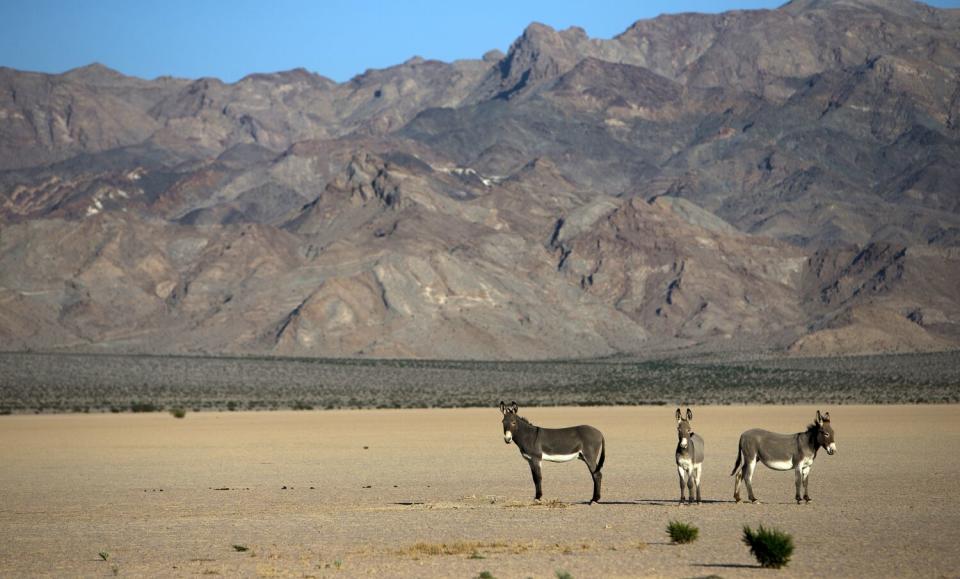Five wild burros shot and killed in Death Valley National Park
Federal authorities are investigating the killing of five wild burros who were found shot to death near life-giving springs on the western edge of Death Valley National Park, where 20-mule teams once pulled wagons of borax.
The National Park Service said it was one of the largest illegal killings of its kind in Death Valley, which is home to roughly 4,000 burros — descendants of the pack animals that miners and prospectors used more than a century ago.
Details about the investigation were scarce. “The burros were killed with a low-caliber firearm not typically used to hunt big game,” park Ranger Nichole Andler said Friday. “They were all together in one area of lower Wildrose Canyon.”
Officials did not say when the carcasses were discovered. However, they did say the killings were not part of ongoing federal efforts to reduce burro populations that have come to dominate the park’s badlands.
“While these animals have a negative impact on the natural and cultural desert environment, these irresponsible actions are not warranted,” Andler said.
Read more: Risk of tap water exposure to toxic PFAS chemicals higher in Southern California
The National Park Service does have the authority to shoot burros, which are not native to western deserts, provided the killing is necessary for the restoration of Death Valley's natural habitat.

Burros, officials say, are known to trample and foul sensitive desert springs and damage historic sites. They can also out-compete such native vegetarians as stately bighorn sheep, tiny kangaroo rats and bulky chuckawalla lizards by devouring available greenery.
The incident at Wildrose Canyon, however, involved the unauthorized discharge of a firearm that posed a threat to public safety, Andler said.
“The abandoned carcasses also endanger native wildlife, who inadvertently ingest toxic lead shot when feeding on the dead animals,” she said.
“Information from park visitors could be very helpful for this investigation,” she added. “Those who submit a tip may do so anonymously.”
In the meantime, federal authorities continue to investigate other incidents in which wild burros were illegally killed in sparsely populated desert regions. Those include the shooting of 13 in 2018 on U.S. Bureau of Land Management land near Beatty, Nev.
A year later, 42 wild burro carcasses with gunshot wounds were found along Interstate 15 between Halloran Springs, Calif., and Primm, Nev.
Some were shot in the neck while drinking water in the Halloran Springs area, officials said.
Animal protection organizations were outraged by that slaughter and contributed thousands of dollars toward a reward of up to $18,000 for information leading to the arrest of those responsible.
They also take exception, however, to the National Park Service’s ongoing efforts to transform Death Valley into a “no-burro zone.”
Burros remain a popular specimen of regional wildlife in the California desert: sure-footed in rugged terrain and capable of carrying heavy loads long distances and withstanding temperature extremes.
Read more: A renegade sea otter is terrorizing California surfers: 'It's a little scary'
In Death Valley, the largest concentrations are in Butte Valley in the southwest corner of the park; Saline Valley in the northwestern section; and Wildrose Canyon on the western border, about five miles south of California Highway 190, a main route into the park.

They are the descendants of animals turned loose by miners and prospectors in the 1920s and '30s and replaced by Model A Fords and other vehicles. Since then, they have multiplied without restraint, with few predators to check their numbers.
By the 1950s, wanton slaughter of wild burros in California’s desert and mountains had reached such proportions that the Society for the Prevention of Cruelty to Animals pressed for legislation to protect the creatures from trigger-happy hunters.
One killing ground was Homewood Canyon, near Trona, about 240 miles northeast of Los Angeles, where SPCA officials in 1953 reported a shocking scene: Over an area of 50 acres, they found 50 burro carcasses. Only a few had bullet holes in the head, indicating that most had been left wounded where they fell.
“What I find so incredible about wild burros is that the National Park Service believes they are scourges of the desert and shouldn’t be there,” said Grace Kuhn, spokeswoman for the nonprofit American Wild Horse Campaign. “Yet, many Americans admire their astonishing resilience and strong sense of preservation.
“They’ve helped build this country and deserve to be treated with respect.”
This story originally appeared in Los Angeles Times.

